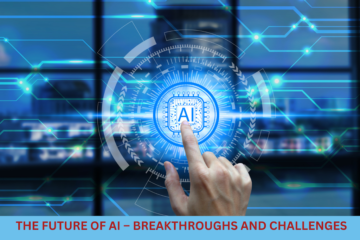Emerging Cybersecurity Threats & Future Defense Strategies
In an age where digital transformation drives the world, cybersecurity has evolved from being an optional safeguard to a fundamental necessity. With every technological advancement, cybercriminals also level up, crafting new, more sophisticated threats. The need to understand these emerging threats and develop resilient defense mechanisms is more urgent than ever. This article dives deep into the future of cybersecurity, highlighting the most alarming threats and the smartest strategies to combat them.
🔥 Emerging Cybersecurity Threats
1. AI-Powered Cyber Attacks
Artificial Intelligence (AI) is transforming cybersecurity — both as a defense tool and a weapon. Cybercriminals are now using AI to automate phishing attacks, crack passwords using behavioral prediction, and deploy adaptive malware that evolves to bypass detection systems. This makes AI-based attacks harder to detect and faster to execute, posing a serious challenge for traditional cybersecurity methods.
2. Next-Gen Ransomware
Ransomware isn’t just about encrypting data anymore. Modern-day attackers use double extortion tactics — they lock the victim’s data and threaten to leak sensitive information if the ransom isn’t paid. Some have even adopted Ransomware-as-a-Service (RaaS) models, enabling amateur hackers to launch deadly attacks with ease. Healthcare, finance, and government sectors remain top targets.
3. Cloud Security Weaknesses
As businesses rapidly move to cloud environments, misconfigured cloud settings, unsecured APIs, and poor identity management have become major vulnerabilities. Cloud-native threats, especially those that exploit storage buckets and access tokens, are rising fast. Cyber attackers now aim for data-rich cloud infrastructures that serve as treasure troves of sensitive information.
4. 5G Networks and IoT Exploits
The global shift to 5G connectivity is revolutionizing speed and data exchange — but it’s also increasing risk. Billions of IoT devices will connect through 5G, making it an attractive playground for cyber attackers. Vulnerabilities in smart home gadgets, connected cars, and wearable tech can be exploited for espionage, disruption, or even physical harm.
5. Deepfakes & Advanced Social Engineering
The manipulation of audio, video, and imagery using AI — aka deepfakes — is enabling hackers to impersonate CEOs, forge identities, and spread misinformation. Combined with social engineering tactics like spear-phishing, attackers are gaining unauthorized access to high-value data with frightening ease.
6. Supply Chain Breaches
Rather than attacking a strong organization directly, cybercriminals now exploit weaker links in its supply chain. A single compromised vendor can become the backdoor into a secure network. These attacks are stealthy, devastating, and increasingly common — as seen in major breaches like SolarWinds and Kaseya.
🛡️ Future-Ready Defense Strategies
1. AI & Machine Learning-Enhanced Defense
To fight AI, we need AI. Cybersecurity tools powered by AI and machine learning can scan vast datasets in real-time, identify anomalies, and respond instantly to suspicious behavior. From predictive threat modeling to automated response systems, AI is the future of proactive cybersecurity.
2. Zero Trust Architecture
The “Zero Trust” model works on a simple principle: Trust nothing, verify everything. Every user, device, and network is treated as a potential threat. This model demands:
-
Continuous authentication
-
Micro-segmentation of network zones
-
Strict access controls
-
Real-time behavioral monitoring
It’s especially effective in protecting remote workers and distributed cloud networks.
3. Threat Intelligence Collaboration
No organization can fight cybercrime alone. Governments, private companies, and cybersecurity communities must share real-time threat intelligence to build stronger collective defenses. Platforms that facilitate global cyber threat sharing will play a key role in preempting large-scale attacks.
4. Blockchain for Data Integrity
Blockchain’s decentralized and tamper-proof nature makes it a powerful ally in cybersecurity. It can help:
-
Prevent data manipulation
-
Protect digital identities
-
Ensure transparent and secure transactions
Blockchain-based solutions are already being tested in healthcare, supply chains, and digital voting systems.
5. Advanced Authentication Methods
Traditional passwords are becoming obsolete. Organizations should move towards:
-
Biometric authentication (fingerprint, face recognition)
-
Multi-factor authentication (MFA)
-
Behavioral biometrics like keystroke dynamics
This reduces the risk of brute-force attacks and unauthorized access.
6. Security Audits & Human Awareness
Technology alone can’t win the cybersecurity war. Human error is still one of the biggest causes of data breaches. That’s why:
-
Regular security audits must be performed to identify weaknesses.
-
Employees must be trained to recognize phishing, fake websites, and suspicious attachments.
Cybersecurity needs to be a company-wide responsibility, not just an IT task.
🧠 Conclusion
The cybersecurity landscape is evolving at lightning speed, and staying ahead means constant adaptation. While threats like AI-powered attacks, ransomware, and deepfakes pose serious challenges, emerging technologies and smart defense strategies offer hope.
Organizations must act now — implementing AI-powered defenses, embracing Zero Trust models, collaborating globally, and investing in education. By adopting a proactive and layered approach to cybersecurity, we can build a safer, more resilient digital world.
Let’s secure the future — one firewall, one biometric scan, and one trusted partnership at a time. 🔐






